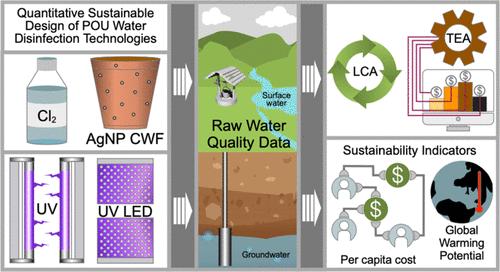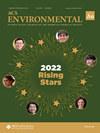评估离网社区用水点消毒技术的相对可持续性
IF 6.7
Q1 ENGINEERING, ENVIRONMENTAL
引用次数: 0
摘要
使用点(POU)水消毒技术可通过在家庭层面处理水,为人们提供安全的饮用水;然而,驾驭各种 POU 消毒技术可能很困难。虽然有许多传统的 POU 设备,但使用新型材料或先进工艺的新兴技术也在开发之中,并声称成本更低,处理能力更强。然而,目前还不清楚这些说法是否属实,也不清楚在提供相同服务(即达到安全饮用水所需的消毒水平)时,新型技术与传统技术在成本和环境影响方面的比较。这项研究评估了四种不同的 POU 技术(使用次氯酸钠进行氯化、银纳米粒子陶瓷滤水器、紫外线汞灯和紫外线发光二极管)的可持续性。利用开源 Python 软件包(QSDsan 和 EXPOsan),通过技术经济分析和生命周期评估,以人均成本(美元-cap-1-yr-1)和全球升温潜能值(千克二氧化碳当量-cap-1-yr-1)评估了这些 POU 技术的成本和环境影响。对地表水和地下水的水质参数(如浊度、硬度)的影响进行了量化,并使用不确定性和敏感性分析来确定哪些假设会影响结果。在采用时间范围内对所有技术进行了进一步评估,并进行了背景分析,以评估技术在全球范围内部署的影响。这项研究的结果有可能为决策者、非营利组织和未来的研究人员提供有价值的见解,帮助他们制定可持续的方法,确保通过 POU 技术获得安全饮用水。本文章由计算机程序翻译,如有差异,请以英文原文为准。

Assessing the Relative Sustainability of Point-of-Use Water Disinfection Technologies for Off-Grid Communities
Point-of-use (POU) water disinfection technologies can be adopted to provide access to safe drinking water by treating water at the household level; however, navigating various POU disinfection technologies can be difficult. While numerous conventional POU devices exist, emerging technologies using novel materials or advanced processes have been under development and claim to be of lower cost with higher treatment capacity. However, it is unclear if these claims are substantiated and how novel technologies compare to conventional ones in terms of cost and environmental impacts when providing the same service (i.e., achieving a necessary level of disinfection for safe drinking water). This research assessed the sustainability of four different POU technologies (chlorination using sodium hypochlorite, a silver-nanoparticle-enabled ceramic water filter, ultraviolet mercury lamps, and ultraviolet light-emitting diodes). Leveraging open-source Python packages (QSDsan and EXPOsan), the cost and environmental impacts of these POU technologies were assessed using techno-economic analysis and life cycle assessment as per capita cost (USD·cap–1·yr–1) and global warming potential (kg CO2 eq·cap–1·yr–1). Impacts of water quality parameters (e.g., turbidity, hardness) were quantified for both surface water and groundwater, and uncertainty and sensitivity analyses were used to identify which assumptions influence outcomes. All technologies were further evaluated across ranges of adoption times, and contextual analysis was performed to evaluate the implications of technology deployment across the world. Results of this study can potentially provide valuable insights for decision-makers, nonprofit organizations, and future researchers in developing sustainable approaches for ensuring access to safe drinking water through POU technologies.
求助全文
通过发布文献求助,成功后即可免费获取论文全文。
去求助
来源期刊

ACS Environmental Au
环境科学-
CiteScore
7.10
自引率
0.00%
发文量
0
期刊介绍:
ACS Environmental Au is an open access journal which publishes experimental research and theoretical results in all aspects of environmental science and technology both pure and applied. Short letters comprehensive articles reviews and perspectives are welcome in the following areas:Alternative EnergyAnthropogenic Impacts on Atmosphere Soil or WaterBiogeochemical CyclingBiomass or Wastes as ResourcesContaminants in Aquatic and Terrestrial EnvironmentsEnvironmental Data ScienceEcotoxicology and Public HealthEnergy and ClimateEnvironmental Modeling Processes and Measurement Methods and TechnologiesEnvironmental Nanotechnology and BiotechnologyGreen ChemistryGreen Manufacturing and EngineeringRisk assessment Regulatory Frameworks and Life-Cycle AssessmentsTreatment and Resource Recovery and Waste Management
 求助内容:
求助内容: 应助结果提醒方式:
应助结果提醒方式:


